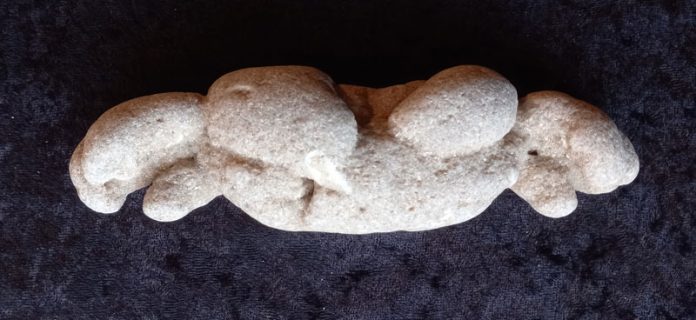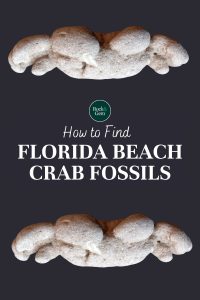
Florida beach crab fossils are prized finds during the aftermath of storms as beachcombers scour the beaches for agatized coral, sea glass, fossil shark teeth and other treasures. On rare occasions, they find something hard to believe. It is a concretion that in size and shape resembles a crab. But the crab is covered in what looks like sand. What could this be?

The story of “ghost crabs” is unique. Crabs are so rare as fossils that they are a prized find. Crabs and other crustaceans have a hard carapace or external shell. This exoskeleton is thin and fragile and falls apart immediately upon death. These discarded shells break into small pieces when washed up on the beach or are broken apart in the tides and currents. But in the case of the ghost crabs, they are found essentially complete. Locals along the line from Eau Gallie Causeway to Pineda, Florida, call these fossils stoned crabs, beach crabs and coquina crabs.
What is Coquina?
Coquina is a sedimentary rock formed almost entirely of ground-up fragments of shells from mollusks and other invertebrates and cemented with grains of sand.
The rich history of Florida’s geography is replete with the advancing and receding of coastline along with fluctuating sea levels. As these shorelines moved, animals died and were buried. Florida also boasts coquina deposits inland that can also be found full of fossils. Florida can be a fossil hunter’s dream!
How Did Whole Fossils Form?
Because of the shape of these crab fossils with their claws folded in front of them as in life, it is believed that these crabs died in their burrows perhaps to escape a winter chill or a quick fall in temperature. When they died in their burrows there was no disarticulation, they remained virtually intact. They then mineralized along with the sand and shell rubble that surrounded them.
The crabs fossilized by the same process that created those ancient coquina rock formations on land in East Central Florida. These coquina deposits are approximately 110,000 years old. Due to offshore dredging, fossils get washed up on the shores of Florida’s beaches. Normally anything washing up on a beach is pulverized rapidly by the incessant waves or abraded by the beach sand. Such is the fate of the ghost crabs of Brevard County – if not found quickly enough.
The crabs are generally covered with a thick layer of heavily cemented sandy matrix. If the crab has been in the surf for quite some time, it can be highly abraded, worn and even slightly polished. Some of the voids between the claws and legs can be infilled with calcium grains, calcite crystals and cemented sand.
Florida’s Coastline
Along Florida’s coast, the barrier island and sand dune system is believed to have formed within the last 7000 years. It is also believed that the crabs could have accumulated over the last 100,000 years. The sandy beaches are smooth and clear of debris during most of the year and it is particularly after hurricanes and strong storms that these crabs wash up on shore and can be easily found. They are rare but usually widely scattered along the beaches.
These crabs are believed to come from two sources of offshore coquina rock deposits to the east which appear to be the ancient shoreline before the retreat of the last Pleistocene Ice Age some 10,000 years ago.
It’s also believed that during the construction of Port Canaveral 70 years ago that dredging activities dislodged much of the Anastasia formation releasing some of these fossils from their long slumber.
Beachcombing is fun and now beachcombers can also be fossil hunters looking for that elusive megalodon tooth…or maybe even a ghost crab.
This story about Florida beach crab fossils previously appeared in Rock & Gem magazine. Click here to subscribe. Story by Joseph J. “PaleoJoe” Kchodl.












